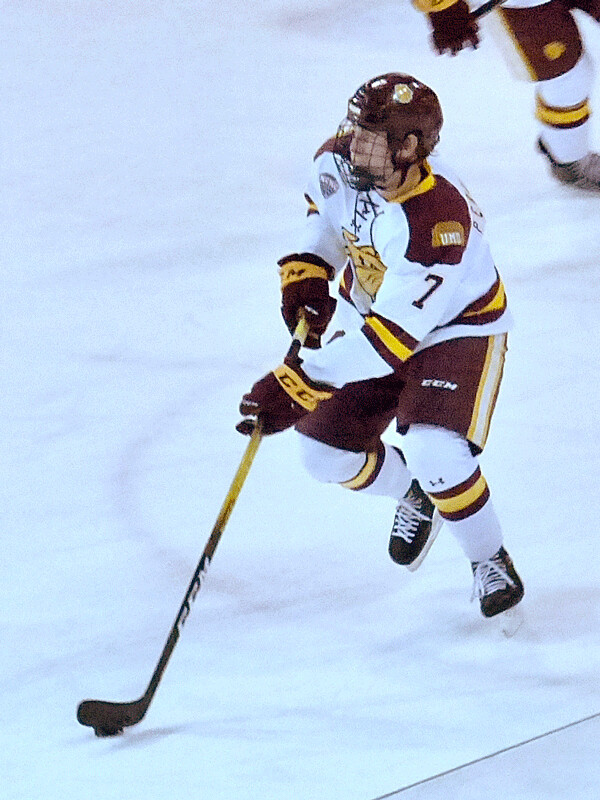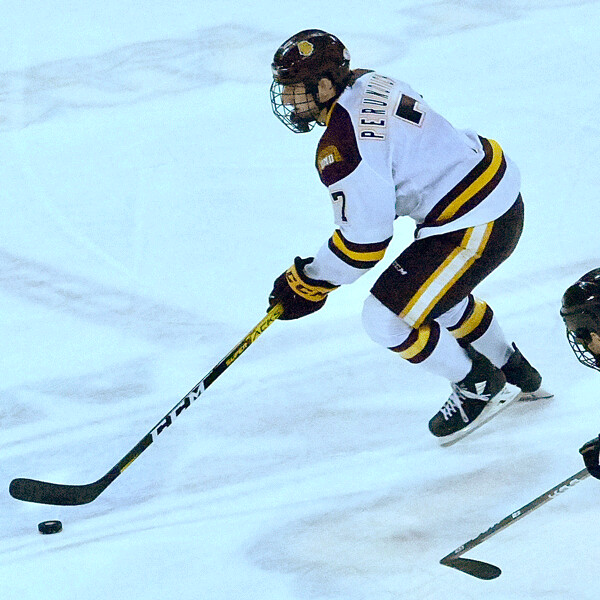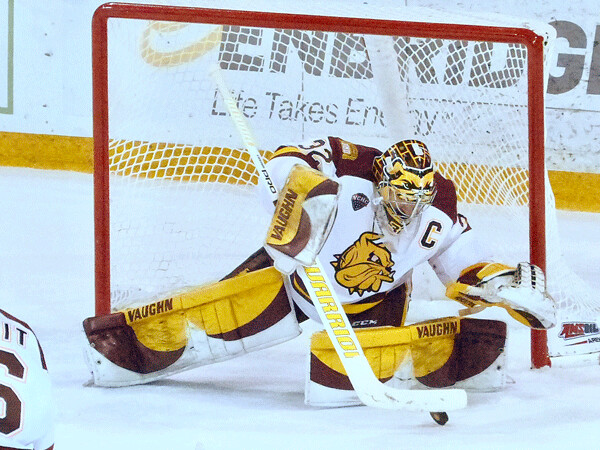News & Articles
Browse all content by date.

Things were pretty normal when a group of us in the sporting media gathered at AMSOIL Arena on Wednesday of last week, for a regular interview session with UMD coach Scott Sandelin and selected members of his two-time defending NCAA championship hockey team.
These young pups — compared to me — asked what I thought was UMD’s best hockey team of the current decade. Without hesitation, I said “This one.” They disagreed, looking back on a couple of the earlier teams that had lifted Sandelin’s Bulldogs to national prominence. No question, that was a magical team that won UMD’s first NCAA title, and you had to love the incredible team that showed up with an untried goaltender, and five freshman defensemen to join the lone returnee — sophomore Nick Wolfe — and then that untried sophomore goalie, named Hunter Shepard, and a leading scorer who was one of those freshmen defensemen, Scott Perunovich, guided the Bulldogs to another NCAA title.
Last year, they won their second straight NCAA title, despite a couple of early signees. Now this season, my pick for Sandelin’s best team ever, has put together a fantastic homestretch. Shepard is a senior now, the best goaltender in the nation; Perunovich as a junior is again leading UMD in scoring from defense, Wolfe is the big, tough veteran and co-captain with Shepard as another senior, and a couple of underclassmen, Cole Koepke and Noah Cates, have risen to the elite level of offensive threats.
That’s why I think this team is the best of the decade. The solid returnees are better players than they were a year ago. We can leave the debate for now, because a week ago I was projecting for the Bulldogs to whip Miami and try to defend its NCHC tournament title this weekend.
But one week ago, everything came to a grinding, frustrating half. And I will make the case that it has a more frustrating impact on these UMD Bulldogs than on any other college or professional athletic team in the country. That’s an enormous claim. But I believe it.
Like everyone else in the Northland last week, I was looking ahead to the weekend, when UMD would take on Miami of Ohio in a best-of-three series for the chance to advance to Saint Paul’s Xcel Center for the Frozen Face-off — the NCHC’s semifinals and finals, which are a huge step toward the NCAA championship.
We knew that crazy Coronavirus was expanding, and inexorably spilling toward us. We didn’t know how bad it would get, or how our society would try to handle it.
The word had already come down that our regional girls high school basketball state tournament teams would have to play with only a designated few fans, as would the boys as they battled a week behind them in sectional play.
Then the word came that the National Collegiate Hockey Conference had declared that all four of its best-of-three playoffs would also have to be played without fans, as trying to prevent large crowds from gathering anyplace was being prohibited. This is a weird ailment, spread by sneezing or contact with someone who might already be infected. So we had to bite the bullet and put up with such comparatively little things.
I didn’t want to admit it, but in a strange way, I was looking forward to covering the UMD-Miami games in an AMSOIL Arena with only the press box occupied, along with the players. I could make a bad joke, and say that I’ve been to a couple Gopher hockey games in the last year or two when Mariucci Arena mimicked that same fan-free atmosphere. And this year, the Gophers had a very exciting best-of-three Big Ten hockey series against Michigan, and while Minnesota won the decisive third game, it was sad to see so few fans interested in watching such important games. Clearly, not more than 1,000, for sure.
I was imagining already the rich hockey sounds of pucks clattering against stick blades, or echoing off the side boards, while eager UMD fans gathered at home or at sports bars around Duluth to catch every second.
And then the word came down. The NCHC was cancelling its tournament games, and the remainder of its pursuit of another NCAA title. The Big Ten also had announced it was cancelling all its sports events “until the end of the academic year.” That had some clout, because it would indicate the elimination of the Big Ten and NCAA hockey competition, and would also eliminate the much-loved NCAA basketball tournament, with its nationwide involvement of office-workers with their office betting pools.
The careless use of the language is a plague of a different type for our society, but understand that in formal journalism you can choose to say either that an event is postponed or cancelled. If it is postponed, it can be rescheduled at a future date; if it is cancelled, it is erased from existence, done. These college conferences were saying “cancelled.”
It also would mean the erasure of all spring sports — no baseball, softball or track competition, national championship tournaments. And no wrestling grand finale, a major money-maker when the collegiate wrestling tournament is held someplace like the Vikings football stadium, where it was scheduled right now. Naturally, UMD’s women’s basketball team, with a chance to advance in the NCAA Division II tournament, was out of commission, too.
The NBA “suspended” the rest of its season and its playoffs, and the NHL followed with the same declaration the next day. Major League Baseball is pushing back the start of its regular season indefinitely. The reason the others were “behind” the NBA is that a Utah player who was found to have been infected with the Coronavirus, jokingly played around touching all sorts of microphones and equipment of media types, so unintentionally, the NBA became the vanguard for all things Coronavirus infected or threatened with getting infected.
Unnoticed by the U.S. media, the World’s Grand Prix auto racing series — Formula 1 — was all set to open its season last weekend with the Australian Grand Prix. It is a particularly compelling opener, because so many teams have been revised, for cars and/or personnel. Word was the dominant Mercedes team had been struggling to get up to competitive speed, adding to the drama. But then it was discovered one of the crewmen for Team McLaren had been infected with the virus, so the race was scratched.
NASCAR, IndyCar and the NHRA followed suit and also cancelled their competitive racing indefinitely.
Now, as a self-appointed chronicler of Northern Minnesota sports and especially hockey, I can restate my case, and my outlandish suggestion that the UMD men’s hockey team are hurt worse than any other sports team.
The Wild could resume their final week at some point in the near future, and maybe get into the playoffs; the Vikings traded away Stefon Diggs, but will not miss a beat when fall camp opens; the Twins can simply push the start of their season back into May or June, if need be. College basketball, baseball, track and Division II and III
will be snuffed from finishing their seasons and possibly their eligibility. But while college hockey doesn’t rank as high with national media types, stop and consider what is at stake in college hockey.
On the heels of our casual little discussion, we learn that the NCHC has announced its annual “best of” finalists, and while my trusty compatriots can go back and pick some past team, which was very good, UMD has a chance at an unprecedented haul. These are the UMD candidates among the three finalists in every category:
Goalie of the year: UMD senior Hunter Shepard is the only NCHC goalie to have started every game this season; he has a 17-5-2 record, a 2.13 goals-against and a .923 save percentage for the award he won last year.
Top Forward: Noah Cates, UMD sophomore, is third in league scoring with 11-16—27, and a plus-10.
Top Defensive Forward: UMD junior Justin Richards, led league with two short-handed goals, was first in face-off wins with 307, was a Plus-9, and blocked 14 shots.

Top Defenseman: Scott Perunovich, UMD junior who won the NCHC scoring title with 32 points, including a record 28 assists, and added 43 blocked shots and a plus-12.
Top Defensive Defenseman: Nick Wolfe, UMD senior captain, recorded a plus-17 and a league-high 58 blocked shots.
NCHC Player of the Year: Scott Perunovich, NCHC scoring champ from defense with 4-28–32, blocked 43 shots, was a plus-12, and was named league defenseman of the week five times.
Herb Brooks Coach of the Year: Scott Sandelin, who led UMD through finishing surge to finish 3 points behind North Dakota. Top contenders are Brad Berry of North Dakota and Andy Murray of Western Michigan.
Those UMD players might not all win, but they have the best credentials. That’s what I was getting at, when I said this is UMD’s best team under Sandelin. And that, also, is why this team has absorbed the most crushing setback by having the Coronavirus eliminate the NCHC and NCAA tournaments.

In the NCAA’s history of hockey, only Michigan in 1952, 53 and 54, has ever won three consecutive NCAA titles. This UMD team could have done that and been inscribed in history. It has the best goalie, who is a senior, the best defensive defenseman in Nick Wolfe who is co-captain with goalie fellow-senior Hunter Shepard, so they both are gone after this season. And Scott Perunovich should be defenseman of the year, NCHC player of the year, and already is the NCHC scoring champion, and although he’s just a junior, he well could sign a pro contract and be gone.
So Minnesota State-Mankato has a legitimate gripe about not getting a chance at the title, and North Dakota could have the same frustration, after being ranked No. 1 and having its chance to win an NCAA title washed out. But no other team has the skilled seniors who have led it to two straight NCAA title and could well win a third in a row — as UMD’s best team — and had it halted by Coronavirus.
The only silver lining might be if Perunovich decides not to sign, and returns for a senior year that could be bigger and better than this one.
| Tweet |


